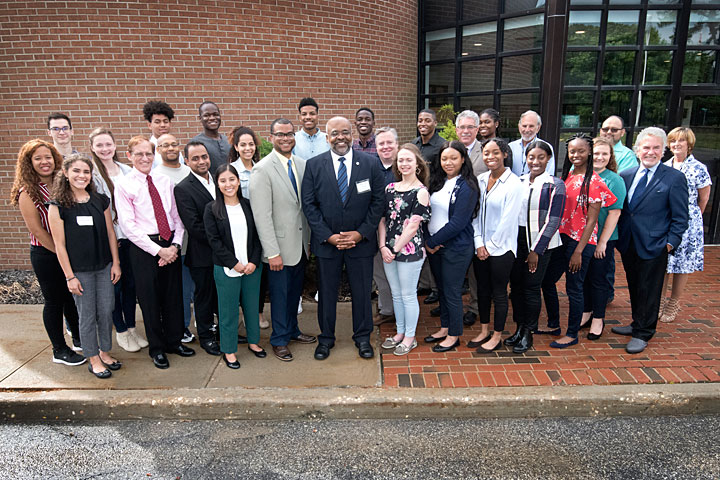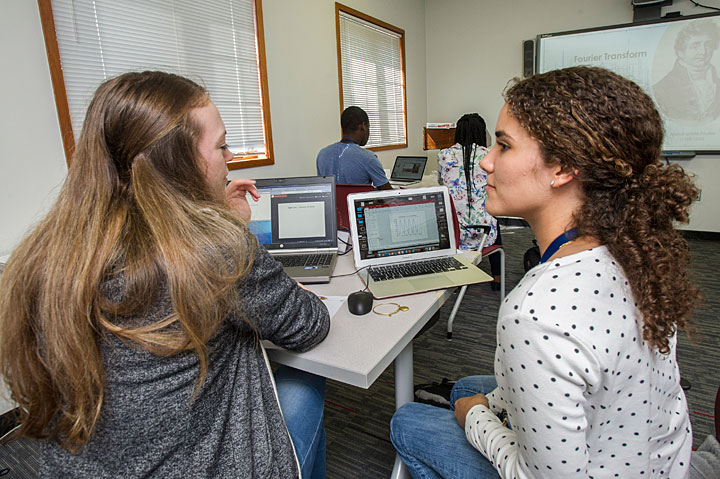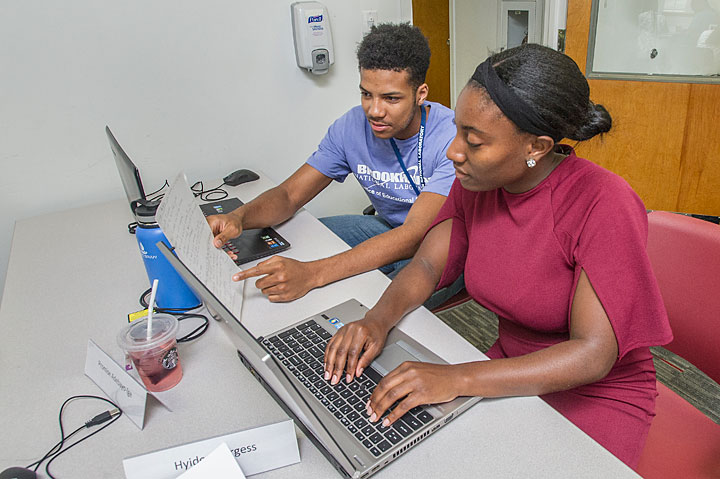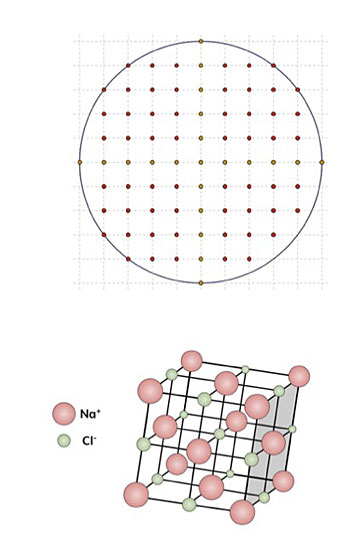Writing Code for a More Skilled and Diverse STEM Workforce
Twenty science, technology, engineering, and mathematics (STEM) undergraduates funded by the National Science Foundation's Louis Stokes Alliances for Minority Participation program came to Brookhaven Lab this summer for a new three-week workshop to develop their scientific computing skills
September 6, 2018
 enlarge
enlarge
This summer, 20 students came to Brookhaven Lab for a new scientific computing skills-building program funded by the National Science Foundation (NSF) and managed by LeRoy Jones (center), program director of NSF's Division of Human Resource Development. Noel Blackburn (to Jones' left), manager of university relations and U.S. Department of Energy programs within Brookhaven's Office of Educational Programs (OEP), submitted the proposal for the program. David Biersach (to Jones' right), a technology architect in Brookhaven's Information Technology Division, was the courseware author and primary instructor for the program. Also pictured in the photo are Brookhaven's Robert Tribble (second from left, front row), deputy director for science and technology; David Manning (right, front row), director of the Stakeholder and Community Relations Office; and Kenneth White, manager of OEP.
The ability to program computers is crucial to almost all modern scientific experiments, which often involve extremely complex calculations and massive amounts of data. However, scientists typically have not been formally trained in science-specific programming to develop customized computational modeling and data analysis tools for advancing their research. Computer science is not always part of the coursework for science, technology, engineering, and mathematics (STEM) college students. If it is, the courses traditionally focus on the theoretical concepts of classical software design rather than on practical problem solving in their respective fields.
The U.S. Department of Energy’s (DOE) Brookhaven National Laboratory has seen this knowledge gap between computational and domain science firsthand. Every year, various Brookhaven Lab departments and facilities offer opportunities for STEM undergraduates to conduct research alongside physicists, chemists, biologists, and other domain scientists.
“In monitoring the performance of our undergraduate interns, we found that most of them do not have the computational capabilities demanded by prospective internships, graduate programs, and employers,” said Noel Blackburn, manager of university relations and DOE programs within Brookhaven’s Office of Educational Programs (OEP).
To help address this need, Blackburn submitted a grant proposal for a three-week introductory scientific computing (scicomp) workshop to the National Science Foundation’s (NSF) Louis Stokes Alliances for Minority Participation (LSAMP) program. This program helps prepare highly qualified students from underrepresented minority groups for STEM careers through partnerships with universities, government agencies, national labs, and industry. Brookhaven Lab and LSAMP first formed an alliance in 2004.
The proposal for the “SciComp Skills-Building Internship Program” was accepted by NSF with a grant to support 20 LSAMP scholars in summer 2018—the first program of its kind. The students arrived at Brookhaven Lab at the end of July.
“Undergraduate research has been formally encouraged by NSF since 1953,” said A. James Hicks, senior program director of LSAMP. “The LSAMP program remains true to this early clarion call, and the SciComp internship is intended to prepare the nation’s talent pool of STEM scholars by teaching college students how to integrate what they have learned in the classroom with computational science to solve real-world problems.”
The SciComp curriculum was developed in partnership with senior scientists from across Brookhaven Lab in the areas of high-energy physics, computational biology, molecular chemistry, astronomy, and environmental science. Through a series of hands-on programming exercises, the LSAMP scholars learned and applied the same data structures and algorithms that Brookhaven scientists use in their research. The students wrote code capable of performing complex modeling and simulation and storing, analyzing, and visualizing very large datasets. In addition to the instructional sessions, the students pursued independent projects, working in teams of two.
Changing scientific computing perceptions
“How do we get a computer to reproduce what we already know? said Brookhaven Lab technology architect David Biersach, who developed the internship courseware and serves as the primary SciComp instructor. “How do we get a computer to solve new problems for which we do not have the necessary physical hardware or theory is not advanced enough to understand? Modern-day science requires the capacity to develop innovative software. But the closer you get to cutting-edge science, the less likely it is that you will find an app for it. You have to write the app yourself.”
 enlarge
enlarge
Alyssa Blanton (left) of the University of Texas and Coral Salort of the University of Puerto Rico, Rio Piedras Campus collaborate on a computational physics problem in which they model the decay of radioactive medical tracers.
For many of the students, this realization was eye-opening.
“I didn’t know that computer science plays such a big role in scientific research,” said Galilea Garcia, a rising sophomore at the University of Georgia. “I’m eager to go back to school and apply my new skills to my research in environmental engineering, which involves lots of modeling and simulations.”
According to Biersach, about half of the participants had no prior computer science experience. Initially, several of them did not think they could handle coding, as they thought they would have to write millions of lines of code. But by the end of the internship, their perception drastically changed, and they became much more confident in their coding abilities. Most of the programs they wrote were only 30 to 40 lines long—short enough to fit on a single presentation slide.
“One of the students was a biology major, and she never coded before so she was very hesitant,” said Biersach. “During the course of the internship, she not only realized that she could code but also that she liked it—so much so that she plans to take computer science courses for an extra semester.”
Reinforcing domain science understanding
By writing code, the students also reinforced what they have been learning in the classroom. Each week, the students took an exam to test their knowledge.
“I have taken two semesters of computer science, but those courses did not focus on science and math as this internship did,” said Emirrah Sanders, who will graduate in 2019 with a degree in chemistry from Alabama A&M University. “I learned how to write code to balance chemical equations, and this skill will help me with my physical chemistry coursework.”
“The memorized scientific formulas do not mean anything until they come to life at a large scale,” said Biersach. “You may think you understand the theory behind a particular scientific concept, but it is not until you have to translate equations into working code that you see if you truly do have that understanding. Too few students can straddle the fence between their science major and computer science.”
For example, a classic lesson taught in college physics is that of the two billiard ball collision—what happens when these balls collide?
“This problem is simple enough to solve for two balls, but what if you instead send a million balls against each other?” said Biersach. “It turns out such large-scale collisions are an effective way to model turbulent airflow over an airplane wing and oxygen flow through the lungs. We show the students how writing code that can run quickly and accurately can be used to model these dynamic processes.”
 enlarge
enlarge
Mustafa Shabazz of the University of Pennsylvania (left) and Hyidea Burgess of Alabama A&M University develop software that can quickly balance complex oxidation-reduction chemical reactions.
Several of the students were surprised at just how quickly computers can help tackle such problems.
“It is cool to see how to solve complex equations in milliseconds while using only four lines of code,” said Matthew Nation, who is a rising senior studying information systems at nearby Stony Brook University.
Victor Hernandez, a rising senior studying chemistry at the University of Puerto Rico, Rio Piedras Campus, similarly noted the time-saving aspect of scientific computing: “Some equations to describe a given chemical system are too complicated to be solved analytically. Instead, the solution must be approximated. We learned that one way to obtain this approximation is through the Monte Carlo method. For example, this method can help us model the structure of chemical compounds with a large number of atoms. It would be very difficult and time-consuming to count every point by hand. With a computer, we can have the answer in milliseconds many times.”
Seeing the bigger picture
 enlarge
enlarge
Code can be used to calculate how many lattice points are inside a given circle. These points refer to the positions where you can place atoms, molecules, or ions to model the structure of a chemical compound, such as salt (NaCl).
In between their instructional sessions and projects, the students heard guest lectures from four Brookhaven scientists: Ketevi Assamagan, a physicist in the Physics Department; Michael De Phillips, a senior scientist in the Nonproliferation and National Security Department; Mark Hybertsen, leader of the Theory and Computation Group at the Center for Functional Nanomaterials (CFN); and Meifeng Lin, a computational scientist in the Computational Science Initiative.
“All of our guest lecturers use computational science as part of their daily routine,” said Blackburn. “They showed the many ways in which custom-developed software can improve their productivity as research scientists.”
The students also toured the CFN, the National Synchrotron Light Source II, and RHIC—all DOE Office of Science User Facilities where scientific computing plays a major role in scientific discovery.
“For STEM undergraduates, nanoscience can be a bit outside the scope of their classroom learning,” said Hybertsen, who hosted the students during their visit to the CFN. “I gave the students some perspective on how nanoscientists can study the structure and properties of materials by combining experimental techniques like x-ray diffraction and electron microscopy with computational tools based on theory. They were very excited to learn that today’s smartphones and computers represent very sophisticated nanotechnology that would not have been possible without many years of developing the software tools that enable modeling and simulations of all aspects of chip design and manufacturing. Using current battery science research as an example, I also showed them how physical models play a key role in the materials discovery process. Having the ability to write and apply code for new models that help interpret experimental results is a crucial skill for frontier research—one that will be a real boost for the students’ future opportunities in STEM.”
On their last day, the students presented their projects at the Lab-wide closing ceremony for this summer’s educational programs.
“I expect something very positive to grow out of this new opportunity for building students’ scientific computing skills,” said Hicks.
“By participating in SciComp, students will be more competitive for internships, such as those offered by DOE at national labs, and employment opportunities,” said Ken White, manager of OEP. “No matter where these students end up—in research, industry, or academia—their new skills will be highly valued. We hope that SciComp will become an annual offering and that the participants of the pilot program come back to Brookhaven next year as interns.”
“We are helping to develop the next generation of scientists with a strong background in scientific computing,” said Blackburn. “By partnering with LSAMP, we are supporting diversity not only in race, but also in thought. Bringing together different ideas is what we need as a nation to stay at the forefront of scientific discovery.”
Brookhaven National Laboratory is supported by the Office of Science of the U.S. Department of Energy. The Office of Science is the single largest supporter of basic research in the physical sciences in the United States, and is working to address some of the most pressing challenges of our time. For more information, please visit science.energy.gov.
Follow @BrookhavenLab on Twitter or find us on Facebook.
2018-13064 | INT/EXT | Newsroom









